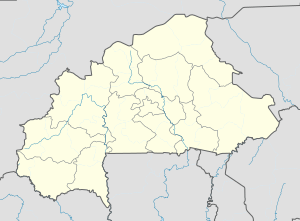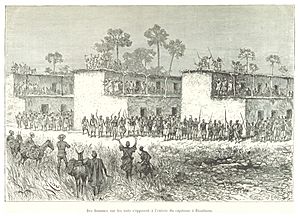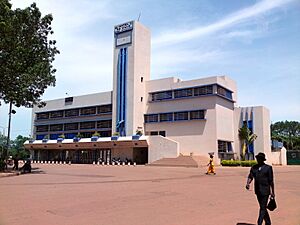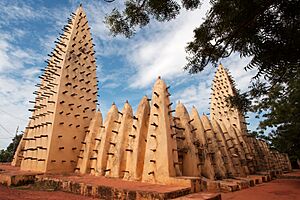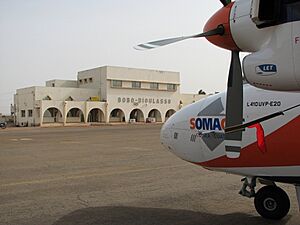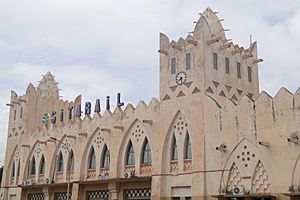Bobo-Dioulasso facts for kids
Quick facts for kids
Bobo-Dioulasso
|
|
|---|---|
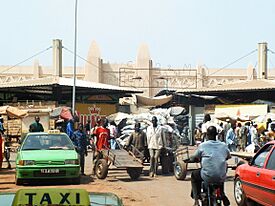
Bobo-Dioulasso marketplace, 2006
|
|
| Country | |
| Region | Hauts-Bassins Region |
| Province | Houet Province |
| Founded | 15th century |
| Area | |
| • Total | 136.78 km2 (52.81 sq mi) |
| Elevation | 445 m (1,460 ft) |
| Population
(2023 census)
|
|
| • Total | 1,129,000 |
| • Density | 8,254/km2 (21,378/sq mi) |
| Time zone | UTC+0 (GMT) |
| Area code(s) | +226 20 |
| Climate | Aw |
| Website | bobodioulasso.net |
Bobo-Dioulasso is a big city in Burkina Faso. About 1,129,000 people lived there in 2023. It is the second-largest city in the country. Only Ouagadougou, the capital, is bigger. The name "Bobo-Dioulasso" means "home of the Bobo and Dioula people."
Local people who speak the Bobo language call the city Sia. There are two different ways people speak the Jula here. This depends on where different groups of people came from. The city is in the southwest of Burkina Faso. It is about 350 kilometers (220 miles) from Ouagadougou. Bobo-Dioulasso is important for its economy, especially for farming and textiles. It is also a major center for culture and music.
Contents
History of Bobo-Dioulasso
In the late 1800s, Sia was made of two main villages. These were Tunuma and Sia itself. They were close to each other, surrounded by deep ravines. Other small villages nearby have now become part of the city.
The French took control of the two main villages on September 25, 1897. This happened after a short fight. Soon after, the French set up their own administrative center. This became the main office for the area, called Bobo-Dioulasso.
During the 1915-16 anti-colonial war, people in the north and east of Bobo-Dioulasso fought against the French. The French used the city as a base to stop the uprising. A military base was also built in the city. This made Bobo-Dioulasso even more important.
In 1927, the French destroyed the old village of Tunuma. Its people moved to other areas. Sia, which is now the Dioulasoba neighborhood, was partly saved. But it was changed a lot in 1932 when a big road was built through it. Between 1926 and 1929, the French built new streets in a grid pattern. This created the layout for the modern city center.
The Abidjan Railway reached Bobo-Dioulasso in 1934. This helped the city connect to markets and transport goods. But the city's growth slowed down during the Great Depression. It also slowed when the colony of Upper Volta was temporarily closed in 1933.
The city began to grow again after World War II. When Upper Volta was reorganized in 1947, businesses came to Bobo-Dioulasso. Even though Ouagadougou became the capital, Bobo-Dioulasso was still a key industrial center. It is also in a rich farming area. This area grows grains, fruits like mangoes, and crops for export like cotton and cashews.
After Burkina Faso became independent in 1960, Bobo-Dioulasso was called "the economic capital." This was because of its strong economy. However, over the years, the government focused more on Ouagadougou. So, Bobo-Dioulasso's economic lead lessened. Not many new industries came in the 1980s and 1990s. Some businesses even closed or moved to the capital. The city's economy mainly relied on trade from farming and services.
Since 2000, Bobo-Dioulasso has started growing fast again. Its population and economy are doing better. People have returned from neighboring Ivory Coast, which has helped the economy. The government has also put more money into developing the city. For example, a new college, the West African Centre for Economic and Social Studies, is being built. It is the first step towards a second university in the country.
City Buildings and Landmarks
Bobo-Dioulasso has many old buildings that show its interesting past:
- Konsa house: This is a special place for the Zara (or Bobo-Jula) group.
- Dafra: This is a sacred natural pond in the south of the city. It is where the We river starts. People visit this pond and offer food to the giant catfish that live there.
- Mausoleum of Guimbi Ouattara: This is a tomb for Guimbi Ouattara. She was an important leader in Bobo-Dioulasso in the 1800s and 1900s.
The city also has well-preserved buildings from the colonial era. They are built in a style called "neo-Sudanic." Examples include the museum and the train station. The regional museum shows the city's long history and old items found there. Other fun places to visit are a zoo and a pottery market.
Education
The École française André Malraux is a French international school. It teaches students from preschool up to middle school.
The Nazi Boni University is also in the city. It was started in 1995.
Places of Worship
Many people in Bobo-Dioulasso are Muslims, and there are many mosques. There are also Christian churches. These include the Roman Catholic Archdiocese of Bobo-Dioulasso (Catholic Church), and churches from groups like the Association of Reformed Evangelical Church of Burkina Faso, Assemblies of God, Deeper Life Bible Church, and International Evangelism Center.
The Grand Mosque of Bobo-Dioulasso is a very famous building. It is possibly the largest example of Sudano-Sahelian architecture in Burkina Faso. Some say it was built in 1880, others say 1893. It was built as part of an agreement between the king of Sya and a Muslim religious leader.
Transportation
The city has a train station. It is part of the Abidjan – Ouagadougou Railway. As of 2014, Sitarail ran a passenger train three times a week in each direction. The Bobo Dioulasso Airport has direct flights twice a week. You can fly to Abidjan and Ouagadougou. The city is also an important road hub. It connects all of Southwestern Burkina Faso to the capital, Ouagadougou.
People of Bobo-Dioulasso
The first people in Bobo-Dioulasso were mostly farmers who spoke the Bobo language. There were also groups who focused on trade and fighting. They also spoke Bobo but saw themselves as different groups. They called themselves the Zara.
Today, Bobo-Dioulasso has many different ethnic groups and languages. This is because it was an old trading town. It also grew a lot in the 1900s as a French administrative and military center. Jula (also called Dioula) is the common language spoken in Bobo and western Burkina Faso. People in the city speak two main types of Jula. The most common Jula spoken in the streets is like Bamana, which is spoken by many people in neighboring Mali.
French colonial officials and soldiers brought this language to the area. Most people speak this Jula as a second language, after French. People of Jula ethnicity, whether traders or religious leaders, speak a different type of Jula. It is similar to the Jula spoken in Ivory Coast, where their ancestors are thought to have come from. In Bobo-Dioulasso, this type of Jula is called Kon-Jula. It helps identify a specific community.
The city's population is growing quickly. It went from 904,920 people in 2019 to 1,129,000 in 2023.
Climate
Bobo-Dioulasso has a tropical wet and dry climate. This means it has a dry season and a wet season. The dry season is from October to April. The wet season lasts for the other five months. During the hottest months, temperatures are a bit cooler than in the capital, Ouagadougou.
The city gets its highest temperatures during the dry season. Average highs are often above 38 degrees Celsius (100 degrees Fahrenheit). But the air is less humid then. So, it might not feel as hot. The wet season has lower temperatures but much higher humidity. This can sometimes make it feel hotter than the dry season. Bobo-Dioulasso gets about 1000 millimeters (39 inches) of rain each year.
| Climate data for Bobo-Dioulasso (1991-2020, extremes 1936-present) | |||||||||||||
|---|---|---|---|---|---|---|---|---|---|---|---|---|---|
| Month | Jan | Feb | Mar | Apr | May | Jun | Jul | Aug | Sep | Oct | Nov | Dec | Year |
| Record high °C (°F) | 39.7 (103.5) |
41.2 (106.2) |
46.0 (114.8) |
42.0 (107.6) |
41.0 (105.8) |
38.6 (101.5) |
36.5 (97.7) |
35.6 (96.1) |
35.6 (96.1) |
37.5 (99.5) |
38.0 (100.4) |
37.5 (99.5) |
46.0 (114.8) |
| Mean daily maximum °C (°F) | 33.1 (91.6) |
35.9 (96.6) |
37.8 (100.0) |
37.4 (99.3) |
35.4 (95.7) |
32.7 (90.9) |
30.6 (87.1) |
29.8 (85.6) |
31.0 (87.8) |
33.5 (92.3) |
34.9 (94.8) |
33.5 (92.3) |
33.8 (92.8) |
| Daily mean °C (°F) | 25.9 (78.6) |
28.8 (83.8) |
31.1 (88.0) |
30.8 (87.4) |
29.3 (84.7) |
27.3 (81.1) |
25.7 (78.3) |
25.0 (77.0) |
25.6 (78.1) |
27.2 (81.0) |
27.9 (82.2) |
26.3 (79.3) |
27.6 (81.7) |
| Mean daily minimum °C (°F) | 19.1 (66.4) |
22.0 (71.6) |
24.7 (76.5) |
25.2 (77.4) |
24.2 (75.6) |
22.7 (72.9) |
21.8 (71.2) |
21.5 (70.7) |
21.5 (70.7) |
22.1 (71.8) |
21.4 (70.5) |
19.4 (66.9) |
22.1 (71.9) |
| Record low °C (°F) | 11.0 (51.8) |
11.0 (51.8) |
11.5 (52.7) |
13.0 (55.4) |
15.2 (59.4) |
17.5 (63.5) |
17.0 (62.6) |
16.7 (62.1) |
15.5 (59.9) |
16.7 (62.1) |
12.8 (55.0) |
10.0 (50.0) |
10.0 (50.0) |
| Average precipitation mm (inches) | 0.7 (0.03) |
1.7 (0.07) |
17.1 (0.67) |
53.7 (2.11) |
98.3 (3.87) |
132.6 (5.22) |
207.3 (8.16) |
269.0 (10.59) |
195.5 (7.70) |
71.6 (2.82) |
5.8 (0.23) |
0.7 (0.03) |
1,054 (41.50) |
| Average precipitation days (≥ 1.0 mm) | 0.2 | 0.1 | 1.3 | 4.0 | 7.7 | 9.1 | 13.1 | 15.5 | 13.6 | 6.9 | 0.8 | 0.1 | 72.4 |
| Average relative humidity (%) | 25 | 25 | 32 | 49 | 63 | 72 | 78 | 82 | 79 | 69 | 51 | 32 | 55 |
| Mean monthly sunshine hours | 277.4 | 250.0 | 248.1 | 227.4 | 247.6 | 225.8 | 206.9 | 178.3 | 208.0 | 266.4 | 284.8 | 279.2 | 2,899.9 |
| Percent possible sunshine | 80 | 76 | 67 | 63 | 68 | 62 | 51 | 48 | 58 | 70 | 79 | 75 | 66 |
| Source 1: World Meteorological Organization | |||||||||||||
| Source 2: Deutscher Wetterdienst (extremes, humidity 1951-1967, and percent sunshine 1961–1990) | |||||||||||||
Famous People from Bobo-Dioulasso
Many talented people come from Bobo-Dioulasso, including:
- Ibrahim Sory Sanlé (born 1943), a famous photographer.
- Gaston Kaboré (born 1951), a film director.
- Moumouni Fabre (born 1953), a politician and diplomat.
- Adama Dramé (born 1954), a musician.
- Cheikh Lô (born 1955), a musician.
- Dani Kouyaté (born 1961), a film director and storyteller (griot).
- Sékou Traoré (born 1962), a film director.
- Alain Traoré (born 1988), a footballer.
- Charles Kaboré (born 1988), a footballer.
- Bertrand Traoré (born 1995), a footballer.
- Lassina Traoré (born 2001), a footballer.
- Issa Kaboré (born 2001), a footballer.
- Nasser Djiga (born 2002), a footballer.
Gallery
-
Stade Général Aboubacar Sangoulé Lamizana. Stadium, 1999
-
.
Detail of a clay minaret of the Great Mosque in Bobo-Dioulasso, 2001
-
.
An iron smith in the blacksmith quarter is working indoors on a sickle with a hammer, 2001
-
.
Low square loam stone houses with trees on the bank of the river with sacred fish, Bobo-Dioulasso, 2001
See also
 In Spanish: Bobo-Dioulasso para niños
In Spanish: Bobo-Dioulasso para niños


